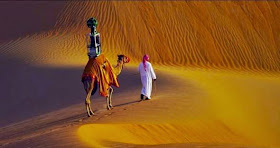Arab Spring seems
to have begun with Mohammed Bouazizi, a 26-year-old Tunisian with 6 kids.
Police had confiscated his vegetable cart – his livelihood - in December of
2010. When officials refused to hear his complaint, he protested by setting
himself on fire. Within a month protesters had ousted Tunisia’s government.[1]
This was the start of Arab Spring, a contagion of protest and revolution that
swept through the Middle East. By 2013, the heads of state in Tunisia, Egypt, Libya,
and Yemen had been chased from office and civil wars had started in two
countries and protests in half a dozen others. These were protests orchestrated
through Twitter and Facebook and played out in the streets with guns and tear gas. Secularists and religious groups have agreed to oust dictators but now
have to agree about how to govern.
For me, this picture of the Camel with Google camera mounted on it seems to capture the Middle East's current, odd juxtaposition of old world and new better than anything I could imagine.
Evolution is hugely defined by environment. The Middle East is going through democratic revolution and reform in such a very different environment than did the West that it will be fascinating to see what it produces. Hopefully, among the things it produces there will be at least a few more pictures like this.


No comments:
Post a Comment